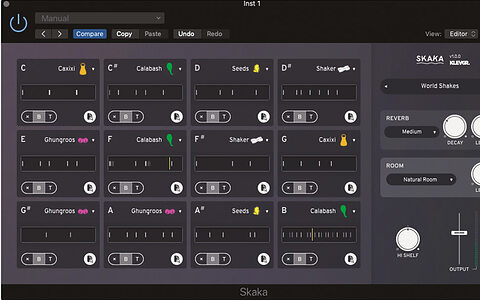
Roland TR-06 & TR-6S
Roland’s unsung TR‑606 is the inspiration for their newest drum machines.
To find the exact phrase, put the words in quotes or join them together with a plus sign e.g. live+recording or "live recording".
To find, say, all live recording articles that mention Avid, enter: live+recording +avid - and use sidebar filters to narrow down searches further.

Roland’s unsung TR‑606 is the inspiration for their newest drum machines.

Rating: ***** 5/5 Stars. The sounds in TXIII don’t veer too far from the previous versions. As well as raw WAV files (for direct dropping into your DAW), these are organised in 28 helpfully named Kontakt nki instruments.

Rating: 5/5 Stars. Featuring a folky line‑up of ocarina, two harmoniums, a bowed glockenspiel and a Swedish nyckelharpa, these are woven together in a set of unique hybrid sounds which include some fabulous electronic textures.

Rating: **** 4/5 Stars. Klevgrand’s Skaka is a sample‑based instrument complete with multiple sequencers designed specifically for creating shaker‑style rhythms.

Rating: 5/5 Stars. This update features some brand‑new content with all the features and content of v2.0: an impressive collection of synth, pad, sound effect and drum options sitting alongside the vocals of Clara Sorace.

With its built‑in compressor set to ‘smash’, the Periscope earns its place in more sessions than you’d think.

A conquering hero returns to the fray after long years in exile. Does the new Prophet Rev 4 still have the power to take on the world?

Steinberg’s clever use of AI has made spectral editing and unmixing more accessible than ever.

After a major overhaul, is Synchro Arts’ VocAlign still an essential part of the vocal producer’s toolkit?

This year’s SOS Awards results celebrate the ‘best in class’ products launched or reviewed in the period from September 2019 through to the end of August 2020. You’ll see all the Winners you selected here as well as the very worthy close contenders in each category, who have been awarded our Highly Commended accolade.

The Echo Cat mimics the famous Watkins hardware tape delay, but is capable of more besides.

I’m addicted to YouTube. A couple of weeks ago, its slightly scary algorithms coughed up a video clip from the BBC’s 1980s ‘...


The Cobalt 8 is a beautifully judged virtual analogue synth.
...
Audio files on this page accompany our February 2021 Cubase workshop.

In this Video, Editor In Chief Sam Inglis explains why mastering engineers are necessary, what they can do for us, and whether we can really replace them with plug-ins!

Olivier and Johannes go behind the scenes on the techniques that they used to create their latest collaborative album featuring the use of VoIP technology to process sound.

The Show Page is designed for live performance, and combines the roles of virtual instrument host, mixer and backing‑track player.

The evolution of convolution takes several steps forward with Inspired Acoustics’ awe‑inspiring immersive reverb.